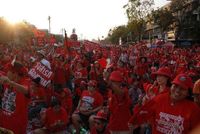In early 2010, Thailand witnessed escalating tensions marked by significant political strife and public unrest. As government disputes intensified, the actions of various political factions ignited a series of confrontations resulting in violence, bomb threats, and asset seizures.
The seeds of protest were sewn in January and February of 2010 when the Red Shirts, a faction associated with the opposition Pheu Thai Party, began mobilizing demonstrations across the nation. The protests, characterized by slogans promoting democratic principles, were largely in response to the ousting of former Prime Minister Thaksin Shinawatra, who had been subject to political and legal scrutiny since he left office in 2006.
On February 13, a tension-filled night marked a pivotal moment. At approximately 10:30 PM, multiple explosions rocked the area near the Rajamangala University of Technology, located close to the government’s seat in Phra Nakhon district, Bangkok. Witnesses reported that M79 grenades were fired into the university grounds, damaging three parked vehicles. This incident signaled the protest’s increasingly violent turn.
Less than twelve hours later, on February 14, authorities stumbled upon an even more alarming situation—a C4 explosive weighing three pounds was found placed within the premises of the Supreme Court. This bomb posed a precarious threat due to its potential destructive radius, which could cause harm within a 50-meter zone. Thanks to vigilant security personnel, the threat was neutralized before any harm could be done.
These acts of violence were viewed as significant political statements, illustrating the desperate measures taken by supporters of Thaksin Shinawatra amidst the political discord. Notably, February 26 bore witness to an essential judicial ruling: the Supreme Court ordered the confiscation of 46,373,867,454.74 baht (approximately $1.4 billion) from Thaksin due to assets acquired improperly during his tenure as Prime Minister.
In conjunction with this legal battle, Finance Minister Korn Chatikavanij announced the freezing of assets belonging to Thaksin’s children, Panthongtae and Pintongtae Shinawatra, amounting to 76 billion baht after previous measures had thwarted their financial maneuvering.
As these legal actions unfolded, voices from the opposition protested loudly, vowing to rally public sentiment against what they saw as a politically motivated crackdown. The demonstrations, spearheaded by leaders such as Veera Musikapong and Jatuporn Promphan, became increasingly complex as they sought to attract additional support.
Not long after the bomb discoveries, on February 27, Mr. Prawat Thongsamu, known as “Khetong”—a figure associated with the so-called “God King’s Soldiers”—hinted at further violent resistance on his online show, predicting that more attacks would follow. Alarmingly, in the following days, there was a coordinated strike involving four explosions at Bangkok Bank branches across Bangkok and Samut Prakan, shaking public confidence amid the chaos.
Investigating authorities quickly traced links back to the Red Shirt movement, indicating a troubling spiral of violence in tandem with political opposition. On March 1, officers sought warrants for the arrest of those believed responsible for the bank bombings, underscoring the gravity of government concerns over growing violence.
Subsequent investigations led police to the offices and residences of various suspects connected to the bombings, resulting in multiple arrests. For instance, police uncovered numerous firearms and ammunition while searching the residence of Khetong, linking him directly to the associated violence and plans for additional attacks.
The situation escalated further when most of the political heavyweights took sides, complicating the atmosphere as various factions publicly traded accusations. Meanwhile, police continued to act; their actions underscored a sense of urgency for public safety as the danger of violent outbreaks remained present.
As the political tension simmered, individuals like Thaksin remained vocal, describing the situation as farcical and expressing his intention to seek justice amid the political tempest. “This is laughable,” he stated, maintaining that, “I will fight for fairness moving forward.”
The Red Shirt protests eventually culminated in calls for renewed democracy, underscoring the willingness of citizens to risk their safety for political reform. The unrest in March, driven by the sustained rhetoric and fervor of the Red Shirt leaders, intensified calls to action against the ruling government led by Prime Minister Abhisit Vejjajiva, who faced extreme pressure from both opposing factions and international observers.
By mid-March, the ongoing struggle showcased how political, social, and economic factors converged with striking intensity as Thailand grappled with its identity, leading to a dramatic showdown that remained unresolved as tensions flared.
The saga of the Red Shirt protests opened up crucial dialogues surrounding representation, governmental accountability, and the struggle for justice in politically turbulent waters. With rounds of protests and counter-protests signifying a nation's deep ideological divide, the events set the stage for Thailand's complex political landscape moving forward.
As Thailand reflects on this chapter, the lessons drawn from its historical precedents resonate profoundly within the current context of societal tensions and democracy.

